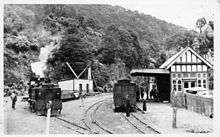Victorian Railways G class
|
Garratt Locomotive G42 at Puffing Billy Railway, 12 August 2007 | |||||||||||||||||||||||||||||||||
| |||||||||||||||||||||||||||||||||
| |||||||||||||||||||||||||||||||||
| |||||||||||||||||||||||||||||||||
| |||||||||||||||||||||||||||||||||
The G class Garratt locomotives were built for the Victorian Railways 2 ft 6 in gauge branch lines. These locomotives were introduced in 1926 to increase train sizes and thus reduce losses on these lines. Their tractive effort was comparable to the most powerful branch line locomotives on the Victorian Railways 5 ft 3 in (1,600 mm), the K class.
Origins
The design was based on the earlier M and Ms class Garratts constructed for the Western Australian Government Railways. This design was amongst the earliest of the Garratts, and first entered service in 1911. The major modification was the use of outside frames to allow for the reduction of gauge from 3 ft 6 in (1,067 mm) to 2 ft 6 in (762 mm). The design proved durable as two further examples were built for the Australian Portland Cement 3 ft 6 in gauge railway at Fyansford in the 1930s.
Working life

The locomotives were allocated numbers G41 and G42. G41 was put to work on the Colac to Beech Forest and Crowes line, while G42 was placed on the Moe to Walhalla railway. The locomotives stayed on these lines, returning to Newport Workshops for heavy repairs. After the closure of the Walhalla line in 1955, G42 was moved west to Colac, where it worked the line in conjunction with G41. At the closure of this line in 1962, only G42 was considered to be in operational condition.
Disposal and preservation

After closure both locos were removed to the Newport Workshops, and G41 was quickly scrapped. The same year the Puffing Billy Preservation Society began operating trains on a portion of the Gembrook line. A museum was established at Menzies Creek, and G42 was obtained for this museum in 1968. The museum also acquired one of the Australian Portland Cement Garratts along with an unused spare boiler. In 1978 a decision was made to restore G42, a task that was finally completed in 2004. The spare boiler from APC was used instead of G42's original boiler as this had had its copper inner fire-box and boiler tubes removed by the V.R. before sale to the Puffing Billy Preservation Society. After restoration, G42 became the regular engine on Puffing Billy's "The Luncheon Train" which operates 7 days a week as far as Lakeside, as well as operating special trains on a semi-regular basis until 2009.
G42 was withdrawn from service in early 2009 pending a "D" exam as part of the Puffing Billy Railway's regular maintenance scheme.
On Sunday 16 August 2009, G42 returned to service for one day only to celebrate "100 years of the Garratt locomotive design" before returning to storage pending the mentioned "D" exam.
On 12 December 2010, G42 moved under its own steam after extensive repairs including turning over 1" from the wheel tires. It was put to a test with a difficult shunt of 20 cars into different roads. The locomotive is now used on the "Green time table" service which otherwise calls for the double heading of NA class locos on one of the trips, enabling its greater hauling capacity to substitute for the two NAs.
As of August 9th 2015, G42 is still currently operating on a regular basis. It will only operate on weekends, special occasions (Public holidays etc.) or if there is a shortage of NAs on running days not covered by the days stated above.
This running schedule was devised in an attempt to prolong G42s service life mainly due to the tire wear caused by the locomotive design and tight curves of the railway.
Gallery
See also
References
Further reading
- Durrant, A.E. (1981). Garratt Locomotives of the World. London: Hamlyn.
- Hocking, P.; Peach, R.; Thompson, J. (1981). G42 Puffing Billy's Big Brother. Belgrave: Puffing Billy Preservation Society.
External links
| Wikimedia Commons has media related to Victorian Railways G class steam locomotives. |







